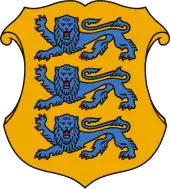Energy in Estonia
| Population (million) |
Prim. energy (TWh) |
Production (TWh) |
Import (TWh) |
Electricity (TWh) |
CO2-emission (Mt) | |
|---|---|---|---|---|---|---|
| 2004 | 1.35 | 60.1 | 41.3 | 19.5 | 7.4 | 16.6 |
| 2007 | 1.34 | 65.5 | 51.2 | 17.9 | 8.4 | 18.1 |
| 2008 | 1.34 | 62.8 | 49.1 | 17.1 | 8.5 | 17.6 |
| 2009 | 1.34 | 55.2 | 48.4 | 14.0 | 8.0 | 14.7 |
| 2012 | 1.34 | 65,1 | 58,6 | 9,1 | 8.4 | 19.3 |
| 2012R | 1.34 | 64.2 | 59.2 | 13.5 | 8.9 | 16.4 |
| 2013 | 1.32 | 70.8 | 65.7 | 10.5 | 8.8 | 18.9 |
| Mtoe = 11.63 TWh . Prim. energy includes energy losses
2012R = CO2 calculation criteria changed, numbers updated | ||||||
Electricity
Electricity production in Estonia is largely dependent on fossil fuels. In 2007, more than 90% of power was generated from oil shale.[2] The Estonian energy company Eesti Energia owns the largest oil shale-fuelled power plants in the world, Narva Power Plants.[3]
Transport sector
Since February 2013, Estonia has for the population of 1.3 million a network of 165 "fast chargers" for electric cars.[4]
References
- IEA Key World Energy Statistics Statistics 2015, 2014 (2012R as in November 2015 + 2012 as in March 2014 is comparable to previous years statistical calculation criteria, 2013, 2012, 2011, 2010, 2009 Archived 2013-10-07 at the Wayback Machine, 2006 Archived 2009-10-12 at the Wayback Machine IEA October, crude oil p.11, coal p. 13 gas p. 15
- Francu, Juraj; Harvie, Barbra; Laenen, Ben; Siirde, Andres; Veiderma, Mihkel A study on the EU oil shale industry viewed in the light of the Estonian experience. A report by EASAC to the Committee on Industry, Research and Energy of the European Parliament European Academies Science Advisory Council. pp. 14–15; 45. May 2007
- "Oil Shale Energetics in Estonia Liive, Sandor (2007) Oil Shale. A Scientific-echnical Journal (Estonian Academy Publishers) 24 (1): 1–4
- Estonia launches national electric car charging network The Guardian 20 February 2013
This article is issued from Wikipedia. The text is licensed under Creative Commons - Attribution - Sharealike. Additional terms may apply for the media files.
